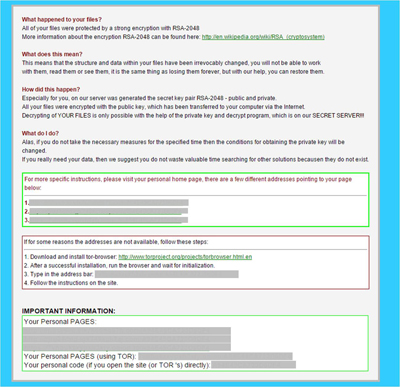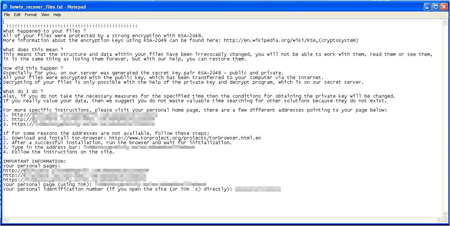RANSOM_CRYPTESLA.YYSII
Artemis!71DF011244A5 (McAfee), TR/Crypt.ZPACK.129250 (Avira)
Windows


Threat Type: Trojan
Destructiveness: No
Encrypted: No
In the wild: Yes
OVERVIEW
Downloaded from the Internet, Dropped by other malware
This Trojan arrives on a system as a file dropped by other malware or as a file downloaded unknowingly by users when visiting malicious sites.
It modifies the Internet Explorer Zone Settings.
It connects to certain websites to send and receive information. It deletes the initially executed copy of itself.
TECHNICAL DETAILS
320,145 bytes
EXE
Yes
25 Sep 2015
Encrypts files
Arrival Details
This Trojan arrives on a system as a file dropped by other malware or as a file downloaded unknowingly by users when visiting malicious sites.
Installation
This Trojan drops and executes the following files:
- %Application Data%\vcw{random}.exe
(Note: %Application Data% is the Application Data folder, where it usually is C:\Documents and Settings\{user name}\Application Data on Windows 2000, Windows Server 2003, and Windows XP (32- and 64-bit); C:\Users\{user name}\AppData\Roaming on Windows Vista (32- and 64-bit), Windows 7 (32- and 64-bit), Windows 8 (32- and 64-bit), Windows 8.1 (32- and 64-bit), Windows Server 2008, and Windows Server 2012.)
Autostart Technique
This Trojan adds the following registry entries to enable its automatic execution at every system startup:
HKEY_CURRENT_USER\Software\Microsoft\
Windows\CurrentVersion\Run
eset_av = %Application Data%\vcw{random}.exe
Other System Modifications
This Trojan adds the following registry keys:
HKEY_CURRENT_USER\Software\zsys
HKEY_CURRENT_USER\Software\{installation ID}
It adds the following registry entries:
HKEY_LOCAL_MACHINE\SOFTWARE\Microsoft\
Windows\CurrentVersion\Policies\
System
EnabledLinkConnections = 1
HKEY_CURRENT_USER\Software\{installation ID}
data = {encryption information}
HKEY_CURRENT_USER\Software\zsys
ID = {installation ID}
HKEY_LOCAL_MACHINE\SOFTWARE\Microsoft\
Windows\CurrentVersion\Run
eset_av = C
Process Termination
This Trojan terminates the following processes if found running in the affected system's memory:
- taskmgr
- procexp
- regedit
- msconfig
Web Browser Home Page and Search Page Modification
This Trojan modifies the Internet Explorer Zone Settings.
Dropping Routine
This Trojan drops the following files:
- %User Profile%\My Documents\recover_file_{random}.txt
- %Desktop%\howto_recover_files.txt
- %Desktop%\howto_recover_files.html
(Note: %User Profile% is the current user's profile folder, which is usually C:\Documents and Settings\{user name} on Windows 2000, XP, and Server 2003, or C:\Users\{user name} on Windows Vista and 7.. %Desktop% is the desktop folder, where it usually is C:\Documents and Settings\{user name}\Desktop in Windows 2000, Windows Server 2003, and Windows XP (32- and 64-bit); C:\Users\{user name}\Desktop in Windows Vista (32- and 64-bit), Windows 7 (32- and 64-bit), Windows 8 (32- and 64-bit), Windows 8.1 (32- and 64-bit), Windows Server 2008, and Windows Server 2012.)
Information Theft
This Trojan gathers the following data:
- Infection status
- Encryption key
- Bitcoin address
- Total size of encrypted files
- Malware version
- OS information
- Tor2web gateway used
- Victim's IP address
- Installation/Victim ID
Other Details
This Trojan connects to the following URL(s) to get the affected system's IP address:
- http://myexternalip.com/raw
It connects to the following website to send and receive information:
- http://{BLOCKED}il.com/misc.php?{data}
- http://{BLOCKED}hyamregency.com/wp-includes/js/thickbox/misc.php?{data}
- http://{BLOCKED}hion.com/wp-admin/network/misc.php?{data}
- http://{BLOCKED}rt.com/wp-includes/certificates/misc.php?{data}
- http://{BLOCKED}rs.ca/wp-includes/theme-compat/cache6b5a98114e3a1366f506f228db64fe99/misc.php?{data}
- http://{BLOCKED}zone.com.au/wp-admin/maint/misc.php?{data}
It encrypts files with the following extensions:
- .3fr
- .7z
- .accdb
- .ai
- .apk
- .arch00
- .arw
- .asset
- .avi
- .bar
- .bay
- .bc6
- .bc7
- .big
- .bik
- .bkf
- .bkp
- .blob
- .bsa
- .cas
- .cdr
- .cer
- .cfr
- .cr2
- .crt
- .crw
- .css
- .csv
- .d3dbsp
- .das
- .dazip
- .db0
- .dba
- .dbf
- .dcr
- .der
- .desc
- .dmp
- .dng
- .doc
- .docm
- .docx
- .dwg
- .dxg
- .epk
- .eps
- .erf
- .esm
- .ff
- .flv
- .forge
- .fos
- .fpk
- .fsh
- .gdb
- .gho
- .hkdb
- .hkx
- .hplg
- .hvpl
- .ibank
- .icxs
- .indd
- .itdb
- .itl
- .itm
- .iwd
- .iwi
- .jpe
- .jpeg
- .jpg
- .js
- .kdb
- .kdc
- .kf
- .layout
- .lbf
- .litemod
- .lrf
- .ltx
- .lvl
- .m2
- .m3u
- .m4a
- .map
- .mcmeta
- .mdb
- .mdbackup
- .mddata
- .mdf
- .mef
- .menu
- .mlx
- .mov
- .mp4
- .mpqge
- .mrwref
- .ncf
- .nrw
- .ntl
- .odb
- .odc
- .odm
- .odp
- .ods
- .odt
- .orf
- .p12
- .p7b
- .p7c
- .pak
- .pdd
- .pef
- .pem
- .pfx
- .pkpass
- .png
- .ppt
- .pptm
- .pptx
- .psd
- .psk
- .pst
- .ptx
- .py
- .qdf
- .qic
- .r3d
- .raf
- .rar
- .raw
- .rb
- .re4
- .rgss3a
- .rim
- .rofl
- .rtf
- .rw2
- .rwl
- .sav
- .sb
- .sid
- .sidd
- .sidn
- .sie
- .sis
- .slm
- .snx
- .sql
- .sr2
- .srf
- .srw
- .sum
- .svg
- .syncdb
- .t12
- .t13
- .tax
- .tor
- .txt
- .upk
- .vcf
- .vdf
- .vfs0
- .vpk
- .vpp_pc
- .vtf
- .w3x
- .wallet
- .wb2
- .wma
- .wmo
- .wmv
- .wotreplay
- .wpd
- .wps
- .x3f
- .xf
- .xlk
- .xls
- .xlsb
- .xlsm
- .xlsx
- .xxx
- .zip
- .ztmp
It opens the following files:
- %Desktop%\howto_recover_files.txt
- %Desktop%\howto_recover_files.html
(Note: %Desktop% is the desktop folder, where it usually is C:\Documents and Settings\{user name}\Desktop in Windows 2000, Windows Server 2003, and Windows XP (32- and 64-bit); C:\Users\{user name}\Desktop in Windows Vista (32- and 64-bit), Windows 7 (32- and 64-bit), Windows 8 (32- and 64-bit), Windows 8.1 (32- and 64-bit), Windows Server 2008, and Windows Server 2012.)
It deletes the initially executed copy of itself
NOTES:
It appends the extension .abc to the filename of the encrypted files.
It drops howto_recover_files_{random letters}.html and howto_recover_files_{random letters}.txt to the folders where the files are encrypted.
It deletes all volume shadow copies using vssadmin.exe.
Here are the screenshots of its ransom notes showing instructions on how to restore the encrypted files by paying in Bitcoin through their onion payment sites:


SOLUTION
9.750
11.940.03
25 Sep 2015
11.941.00
26 Sep 2015
Step 1
Before doing any scans, Windows XP, Windows Vista, and Windows 7 users must disable System Restore to allow full scanning of their computers.
Step 2
Note that not all files, folders, and registry keys and entries are installed on your computer during this malware's/spyware's/grayware's execution. This may be due to incomplete installation or other operating system conditions. If you do not find the same files/folders/registry information, please proceed to the next step.
Step 3
Restart in Safe Mode
Step 4
Delete this registry key
Important: Editing the Windows Registry incorrectly can lead to irreversible system malfunction. Please do this step only if you know how or you can ask assistance from your system administrator. Else, check this Microsoft article first before modifying your computer's registry.
- HKEY_CURRENT_USER\Software\zsys
- HKEY_CURRENT_USER\Software\{installation ID}
Step 5
Delete this registry value
Important: Editing the Windows Registry incorrectly can lead to irreversible system malfunction. Please do this step only if you know how or you can ask assistance from your system administrator. Else, check this Microsoft article first before modifying your computer's registry.
- In HKEY_CURRENT_USER\Software\Microsoft\Windows\CurrentVersion\Run
- eset_av = %Application Data%\vcw{random}.exe
- eset_av = %Application Data%\vcw{random}.exe
- In HKEY_LOCAL_MACHINE\SOFTWARE\Microsoft\Windows\CurrentVersion\Policies\System
- EnabledLinkConnections = 1
- EnabledLinkConnections = 1
- In HKEY_LOCAL_MACHINE\SOFTWARE\Microsoft\Windows\CurrentVersion\Run
- eset_av = C
- eset_av = C
Step 6
Search and delete this file
- %User Profile%\My Documents\recover_file_{random}.txt
- %Desktop%\howto_recover_files.txt
- %Desktop%\howto_recover_files.html
- howto_recover_files_{random}.txt
- howto_recover_files_{random}.html
Step 7
Reset Internet security settings
Step 8
Restart in normal mode and scan your computer with your Trend Micro product for files detected as RANSOM_CRYPTESLA.YYSII. If the detected files have already been cleaned, deleted, or quarantined by your Trend Micro product, no further step is required. You may opt to simply delete the quarantined files. Please check this Knowledge Base page for more information.
NOTES:
Restore encrypted files from backup.
Did this description help? Tell us how we did.

